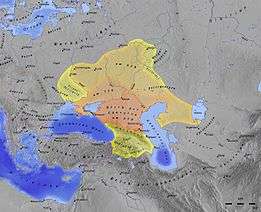Red Jews
The Red Jews were a legendary Jewish nation that appear in vernacular sources in Germany during the medieval era until about 1600. According to these texts, the Red Jews were an epochal threat to Christendom, and would invade Europe during the tribulations leading to the end of the world.
Andrew Gow studied the original German language texts and concluded that the legend of the Red Jews was a conflation of three separate traditions: the Biblical prophetic references to Gog and Magog, the Ten Lost Tribes of Israel, and an episode from the Alexander Romance, in which Alexander the Great encloses a race of heathens behind a great wall in Caucasus. These traditions had some overlap already; Gog and Magog are among the nations trapped behind the wall in the Alexander Romance, and the only ones named in the version of the story appearing in Qur'an Sura al-Kahf (The Cave) 18:89, while The Travels of Sir John Mandeville explicitly associates the confined nations with the Ten Lost Tribes.
Many pamphlets circulated interpreting such events as the rise of Turkish power in the context of the legendary Red Jews. Philipp Melanchthon, for example, claimed that the Ottoman Turks and Muslims were the Red Jews.
Kevin Alan Brook, among others, speculated, but could not conclusively prove, that the legend of the Red Jews was actually based on misremembered accounts of the Khazars. Indeed, in Expositio in Matthaeum Evangelistam, Christian of Stavelot refers to the Khazars as Hunnic descendants of Gog and Magog, as well as having been "enclosed" by Alexander, but having since escaped, demonstrating that the Khazars were indeed conflated with two of the three elements making up the legend of the Red Jews. Other medieval sources consider various connections with the Lost Tribes, and they are described in Arabic sources as having red hair, a trait associated with the Devil in medieval Germany and possibly the source of the term "Red Jews".
See also
- Anti-Turkism
- Antisemitism
- Brutakhi
- History of the Jews in Germany
- Jewish Bolshevism
- Khazars
- Prester John
References
- Anderson, Andrew Runni. Alexander's Gate, Gog and Magog, and the Inclosed Nations. Cambridge, MA: Medieval Academy of America, 1932.
- Brook, Kevin Alan. The Jews of Khazaria. 2nd ed. Rowman & Littlefield Publishers, Inc, 2006.
- Christian of Stavelot. Exposito in Matthaeum Evangelistam.
- Gow, Andrew C. The Red Jews: Antisemitism in an Apocalyptic Age, 1200-1600. Brill, 1994.
- Rabb, Theodore "Action and Conviction in Early Modern Europe: Essays in Honor of E.H. Harbison, Princeton University Press, 1969
